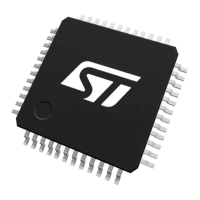Universal serial bus full-speed host/device interface (USB) RM0444
1264/1390 RM0444 Rev 5
Each endpoint/channel is associated with a buffer description block indicating where the
endpoint/channel-related memory area is located, how large it is or how many bytes must
be transmitted. When a token for a valid function/endpoint pair is recognized by the USB
peripheral, the related data transfer (if required and if the endpoint/channel is configured)
takes place. The data buffered by the USB peripheral are loaded in an internal 16-bit
register and memory access to the dedicated buffer is performed. When all the data have
been transferred, if needed, the proper handshake packet over the USB is generated or
expected according to the direction of the transfer.
At the end of the transaction, an endpoint/channel-specific interrupt is generated, reading
status registers and/or using different interrupt response routines. The microcontroller can
determine:
• which endpoint/channel has to be served,
• which type of transaction took place, if errors occurred (bit stuffing, format, CRC,
protocol, missing ACK, over/underrun, etc.).
Special support is offered to isochronous transfers and high throughput bulk transfers,
implementing a double buffer usage, which permits to always have an available buffer for
the USB peripheral while the microcontroller uses the other one.
A special bit THR512 in register USB_ISTR allows notification of 512 bytes being received
in (or transmitted from) the buffer. This bit must be used for long ISO packets (from 512 to
1023 bytes) as it facilitates early start or read/write of data. In this way, the first 512 bytes
can be handled by software while avoiding use of double buffer mode. This bit works when
only one ISO endpoint is configured.
The unit can be placed in low-power mode (SUSPEND mode), by writing in the control
register, whenever required. At this time, all static power dissipation is avoided, and the USB
clock can be slowed down or stopped. The detection of activity at the USB inputs, while in
low-power mode, wakes the device up asynchronously. A special interrupt source can be
connected directly to a wakeup line to permit the system to immediately restart the normal
clock generation and/or support direct clock start/stop.
Host mode and specific functionality
A single bit, HOST, in register USB_CNTR permits Host mode to be activated. Host mode
functionality permits the USB to talk to a remote peripheral. Supported functionality is
aligned to Device mode and uses the same register structures to manage the buffers. The
same number of endpoints can be supported in Host mode, however in Host mode the
terminology “channel” is preferred, as each channel is in reality a combination of the
connected device and the endpoint on that device. The basic mechanisms for packet
transmission and reception are the same as those supported in Device mode.
When operating in Host mode, the USB is in charge of the bus and in order to do this must
issue transaction requests corresponding to active periodic and non-periodic endpoints. A
host frame scheduler assures efficient use of the frame. Connection to hubs is supported.
Connection to low speed devices is supported, both with a direct connection and through a
hub.
Double-buffered mode, as previously described in Device mode, is also supported in Host
mode, in both bulk and isochronous channels. The THR512 functionality is also supported
(but as in Device mode) only for ISO traffic.
Note: Unlike in Device mode, where there is a detection of battery charging capability (in order to
facilitate fast charging), there is no integrated support in Host mode to present battery

